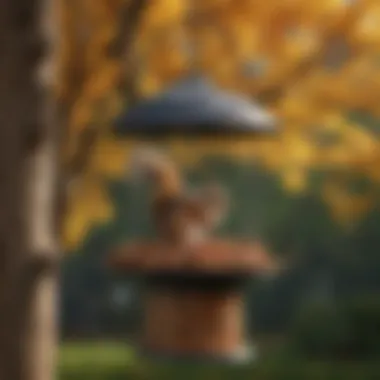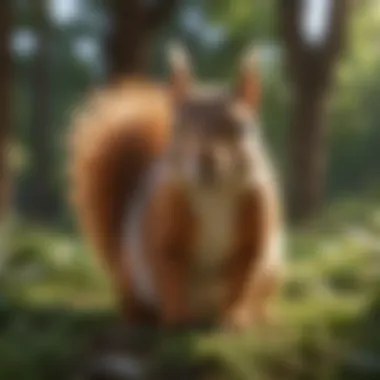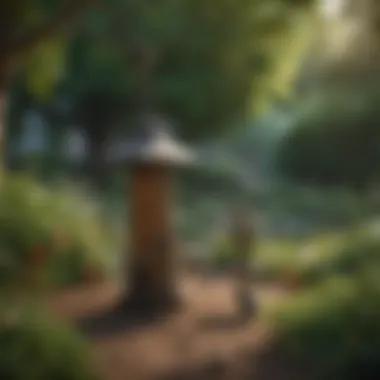Effective Strategies to Keep Squirrels Away from Bird Feeders


Intro
Squirrels are known for their agility and resourcefulness, often finding ways to reach bird feeders, much to the dismay of gardening enthusiasts. They are not just a nuisance; their persistent foraging can lead to significant competition for food among birds. Effective deterrence is crucial for those who want to create a thriving environment for avian species. This article explores various methods to keep squirrels at bay while maintaining a welcoming habitat for birds.
Design Inspirations
In the realm of bird feeders, design plays an essential role in both functionality and aesthetics. Selecting a feeder that not only attracts birds but also repels squirrels can make a substantial difference.
Trending Styles
Innovative designs have emerged that incorporate both beauty and practicality. Some options include:
- Baffle Feeders: These feeders use a dome-like structure above or below the feeding area to block squirrels' access.
- Squirrel-proof Feeders: Many of these feeders have mechanisms that close off access when a heavier animal, like a squirrel, attempts to feed.
- Caged Feeders: These options have a protective cage, allowing smaller birds to access the food while keeping squirrels out.
By choosing trendy styles, homeowners can enhance their garden's appeal while safeguarding birdseed.
Color Palettes
Color selection can also affect how the feeder blends into the surroundings. Earthy tones or colors that mimic the natural environment often work best. Shades like muted greens, browns, or even gray can camouflage the feeder, making it less noticeable to squirrels. This approach not only keeps the feeders attractive but also maintains the overall harmony of the garden space.
Maintenance and Upkeep
To ensure the long-term effectiveness of deterrence methods, regular maintenance is essential. Neglecting feeders can lead to pests taking advantage of broken barriers or compromised designs.
Seasonal Maintenance Checklist
Regular checks and repairs should be made throughout the seasons. Consider the following:
- Inspect for wear and tear on feeding mechanisms.
- Clear out old seed to prevent mold, which can deter birds.
- Ensure that any baffles or cages are functioning effectively.
Cleaning and Organization Tips
Maintaining cleanliness is beneficial for bird health and helps deter unwanted animals. A few suggestions include:
- Use a mild soap and water solution for washing feeders; avoid chemical cleaners.
- Organize feeders in a specific area to make cleaning easier.
- Store food in sealed containers to prevent attracting squirrels.
"An effective feeding station is not only about keeping squirrels out; it's about providing a sanctuary for birds."
With these methods detailed, it is evident that careful planning and regular upkeep can significantly reduce squirrel interference. Designing feeders with both aesthetic and functional qualities will enhance the beauty of any garden while ensuring that it serves as a safe haven for birds.
Understanding Squirrel Behavior
Understanding the behavior of squirrels is a critical aspect in the fight against them raiding bird feeders. Squirrels are clever creatures. They possess the intelligence to overcome obstacles. Hence, knowing their habits helps in designing more effective deterrents. This section outlines key elements about the nature of squirrels, their feeding habits, and their seasonal activity. By grasping these factors, one can implement better strategies to protect bird feeders and ensure a thriving bird environment.
The Nature of Squirrels
Squirrels belong to the family Sciuridae, a family that includes tree squirrels, ground squirrels, and flying squirrels. They are widely recognized for their agile movements and dexterous paws. Squirrels are primarily herbivorous but they also consume insects and small animals. Their sharp front teeth allow them to gnaw through tough materials. This adaptability is one reason they are often seen as pests in gardens. Understanding their nature helps in creating environments that are less accessible to them.
Squirrels' Feeding Habits
Squirrels are opportunistic feeders. They are known to binge on food when it's available. This includes seeds, nuts, fruits, and even human food scraps. Their feeding preference is influenced by the season. During autumn, they tend to gather and store nuts for winter. This behavior often leads to them raiding bird feeders for extra food sources. By recognizing these habits, you can adjust feeder offerings. Offering less appealing food at certain times can keep squirrels at bay.


Seasonal Variations in Squirrel Activity
The activity of squirrels changes with the seasons. In spring, they are more active as they search for food to feed their young. Summer ensures a steady food supply due to abundant vegetation. Autumn sees them foraging intensely to gather food for winter. During winter, they remain less active. They rely on food caches built earlier. Applying knowledge of these seasonal variations can inform the strategic timing of when to set up feeders and the types of seeds to use.
Understanding how squirrels operate is not just about deterring them; it's about working with nature to create a more harmonious environment for all creatures.
By comprehending the core aspects of squirrel behavior, homeowners and gardening enthusiasts can develop tactics that minimize the impact of these critters on bird feeds. This foundational knowledge is instrumental for effectively addressing the challenge of squirrels in gardens.
Types of Bird Feeders
Understanding the various types of bird feeders is essential for anyone aiming to protect their bird food from squirrels. Each feeder style has unique attributes that can either deter or attract unwanted visitors. Selecting the right type influences not only the bird species you attract but also the effectiveness of your squirrel deterrent strategies. This differentiation is crucial for maintaining an enjoyable birdwatching experience in your garden.
Hopper Feeders
Hopper feeders are quite popular among bird enthusiasts due to their design that allows for ample storage of birdseed. They are generally box-shaped and feature a small entrance for birds to access the food inside. The significant advantage of hopper feeders is their ability to hold a considerable amount of seed, which means less frequent refills. However, their design can also make them vulnerable to squirrels, who may easily jump on top and access the food.
To enhance their efficacy against squirrels, look for hopers with weight-activated mechanisms. These devices cause the feeder's doors to close when a heavier animal, such as a squirrel, lands on it. This feature can help in keeping the bird food secure while allowing smaller birds to feed freely. Another consideration is the material. Choose metal or reinforced plastic options over wood, as squirrels can easily gnaw through wood structures.
Tube Feeders
Tube feeders are a favorite choice for many. They consist of a vertical tube with feeding ports along the sides. Their design encourages small birds like finches to come and feed, while also minimizing squirrel access. The narrow nature of tube feeders often makes it challenging for larger animals to reach the feed.
To maximize the efficiency of tube feeders, consider those with a weight-sensitive perch. These versions close off access to feeders if a heavier animal, including squirrels, attempts to feed. Installation height is also a consideration; a well-placed tube feeder can make it harder for squirrels to reach. Additionally, consider a design with drainage holes to ensure that the seed remains dry, avoiding spoilage.
Platform Feeders
Platform feeders, typically flat and open, attract a variety of birds but have their drawbacks when it comes to keeping squirrels at bay. Due to their exposed nature, squirrels can easily access the food. While these feeders are excellent for attracting larger birds, such as doves, they require more innovative strategies for squirrel deterrence.
Adding barriers around the area where you place platform feeders can help minimize squirrel access. You might also consider enclosing them in a wire mesh cage with openings large enough for birds to jump through but too small for most squirrels. Furthermore, strategic placement is vital. Keep them far enough from trees or fences where squirrels could launch an attack.
Effective feeder choice requires balancing the needs of your avian visitors with those pesky squirrels.
By understanding the specific characteristics of each type of feeder, homeowners can make informed decisions. This attention to detail aids in enhancing birdwatching experiences while effectively deterring squirrels.
Designing Squirrel-Proof Feeders
Creating squirrel-proof feeders is an essential strategy in maintaining the balance between bird feeding and the persistent activities of squirrels. The right design can deter these clever rodents while also providing an inviting space for birds. This section will explore various elements within this topic and their significance.
When designing a feeder with this purpose in mind, several factors must be considered, including the material, feeder type, and ability to withstand squirrel attempts. Investing in a well-constructed bird feeder not only enhances the longevity of the feeder but also preserves the quality of the feed. Additionally, using the right design can lead to a reduction in seed loss, providing maximum sustenance for the birds visiting your garden.
Weight-Activated Mechanisms
Weight-activated mechanisms are one of the most effective methods for creating squirrel-proof feeders. These designs utilize a balance system that ensures that only smaller birds can access the food. When a larger animal, such as a squirrel, climbs onto the feeder, the weight triggers a mechanism that closes off access to the seed.
These feeders include features like springs or traps that seal the feeding ports. When implemented correctly, weight-activated mechanisms can significantly reduce squirrel access without limiting birds. Homeowners can find various models, ranging from those with simple designs to more sophisticated installations. When choosing one, look for products made from durable materials to ensure the feeder withstands the elements and the weight of persistent squirrels.
Enclosed Feeders
Enclosed feeders provide an alternative approach to deterring squirrels. These feeders have solid walls or roofs that restrict access to the food within. The main idea behind enclosed feeders is to create barriers that only birds can navigate.
Many designs feature small openings that allow birds—but not squirrels—to enter. Some enclosed feeders use wire mesh or similar materials to create visibility and airflow while maintaining security for the seeds. Choosing an enclosed feeder not only helps in preventing squirrels but also protects the feed from adverse weather conditions. Homeowners should ensure that the design allows for easy filling and cleaning, as maintenance is key to keeping the feeder functional and appealing to birds.


Baffles and Shields
Best practices in deterring squirrels also involve the use of baffles and shields. These devices are installed either below or above the feeder. They act as physical barriers that make it difficult for squirrels to reach the seeds. Baffles are typically dome-shaped or conical, guiding squirrels away from the feeder.
They can be mounted on poles or positioned above hanging feeders to create an obstacle course for squirrels.
While these measures do not guarantee absolute prevention, they can significantly reduce the chances of squirrels raiding feeders. Ensuring that baffles are correctly installed can make a tough job for any squirrel and discourage their attempts. Homeowners might also consider adding multiple baffles at various heights for extra protection.
Note: A combination of methods often yields the best results. Utilizing weight-activated mechanisms alongside baffles can create an effective squirrel-proof feeding environment.
Strategic Placement of Feeders
The placement of bird feeders is crucial in controlling squirrel access. Squirrels are resourceful creatures, capable of jumping impressive distances and climbing various structures. Therefore, understanding how to manipulate their environment can significantly reduce their interactions with bird feeders. Considerations for height, distance from trees, and separating feeders from potential squirrel launching points play a vital role in this strategy.
Height Considerations
Positioning feeders at an appropriate height is one of the simplest yet most effective methods. An ideal height is around five to six feet above ground. This elevation makes it more difficult for squirrels to reach the feeders. Moreover, ensuring that the feeders are at least three feet away from any vertical structure—like poles or tree trunks—is essential. This distance prevents squirrels from using these structures as launching pads to leap onto the feeders. Additionally, many feeders are designed with specific height features, which can also discourage squirrel access.
Location Relative to Trees
Trees can be a significant factor in squirrel activity around feeders. Placing bird feeders far from trees diminishes the chances of squirrels launching themselves onto the feeders. If a tree is within eight to ten feet, squirrels can easily make the jump. When selecting a location, take note of any nearby tree branches that might provide a direct path to the feeder. If removing trees is not an option, consider using squirrel baffles on poles or hanging the feeders in a way that the squirrels cannot reach.
Using Distance to Deter Squirrels
Creating distance is an essential tactic in squirrel deterrence. The greater the space between the feeder and possible access points, the less likely it is for squirrels to manage an approach. It is advisable to maintain a minimum distance of ten feet from any large object—trees or fences. In addition, using barriers such as decorative fencing can also reinforce this distance while enhancing garden aesthetics. This approach plays a dual role: it limits squirrel success and provides a pleasant view for bird watchers.
"Strategic feeder placement not only protects bird food but also allows for optimal birdwatching experiences."
By strategically placing feeders, homeowners can implement practical solutions against squirrels. These efforts will not only preserve bird feeding but also enhance the enjoyment of observing local wildlife. Understanding small details in height and location can lead to significant results in keeping these persistent rodents at bay. For further reading, you can explore resources such as Wikipedia for information on squirrel habits.
Deterrents for Squirrels
Deterring squirrels from bird feeders is crucial for maintaining bird populations and enhancing garden aesthetics. Squirrels can be persistent foragers, leading to the depletion of bird food meant for colorful species like finches and cardinals. By understanding various deterrents, homeowners can successfully protect their feeders while still attracting a vibrant array of birds. This section will explore natural options, chemical methods, and ultrasonic devices that serve to discourage squirrels effectively.
Natural Deterrents
Natural deterrents are a gentle yet effective way to protect bird feeders from squirrels. These solutions often use scents, tastes, or physical barriers that are unappealing to squirrels but safe for birds. Common options include:
- Capsaicin: Derived from hot peppers, capsaicin can be applied to birdseed. While birds have no taste receptors for spiciness, squirrels do, making this a viable deterrent. It is important to reapply after rain.
- Mint Oil: The strong smell of mint oil is often off-putting to squirrels. Sprinkling a bit around feeders or using mint oil-infused sprays can create a barrier that discourages them.
- Cayenne Pepper: Similar to capsaicin, this spice deters squirrels when mixed with birdseed. Regular application may be necessary to maintain its effectiveness.
Natural methods have the benefit of being eco-friendly and not harmful to the surrounding environment, making them a considerate choice for wildlife enthusiasts.
Chemical Repellents
Chemical repellents can provide a more aggressive approach to deter squirrels. These substances are designed to create a barrier or unpleasant experience for squirrels. While many chemical options exist, they should be used with caution to avoid harming birds.
- Commercial Squirrel Repellents: These are specifically formulated sprays that contain ingredients unsafe for squirrels. They create an unpleasant experience when squirrels attempt to approach the feeders.
- Bitter-tasting Agents: Some gardeners use solutions that have a bitter taste. When sprinkled on or mixed with bird food, squirrels will often abandon the feeder due to the unpleasant flavor.
It is critical to read and follow instructions closely when using chemical repellents. Additionally, consider the impact on non-target species, ensuring it remains safe for birds.
Ultrasonic Devices


Ultrasonic devices represent a modern solution to the squirrel dilemma. These devices emit high-frequency sounds that are disruptive to squirrels but usually inaudible to humans. This method offers consistency without needing constant maintenance or reapplication.
- Operation: Once set up, these devices continuously emit sounds that irritate squirrels. They can be effective over a significant distance, covering multiple feeders.
- Advantages: These devices require no chemicals or physical modifications to feeders. They are particularly appealing for homeowners who prefer a low-maintenance solution.
- Considerations: Effectiveness may vary depending on the area and specific designs of the device. It is wise to choose models with adjustable frequencies to better suit different environments.
"Incorporating a combination of these deterrents can lead to the best results against squirrels, ensuring both birds and the garden thrive."
In summary, employing a diverse array of deterrents can significantly minimize squirrel interference at bird feeders. Understanding the specific mechanisms and efficacy of each deterrent helps homeowners develop a strategy that meets their individual needs.
Feeding Alternatives for Birds
Feeding birds is a rewarding pursuit that can connect you with nature and enhance your garden's ecosystem. However, when squirrels invade with their insatiable appetites, it can disrupt the balance you want to achieve. Exploring feeding alternatives for birds not only addresses the problem of squirrel interference but also promotes the health and diversity of bird populations in your area. These alternatives provide practical solutions that both protect your feeders and educate you on bird nutrition.
Selecting Bird-Safe Feed
Choosing the right feed is crucial for attracting birds while deterring squirrels. High-quality birdseed, such as black oil sunflower seeds, can appeal to various species without drawing in unwanted pests. Avoid using seeds that are commonly favored by squirrels, such as corn and peanuts. These attract squirrels and diminish the chances for smaller birds. By selecting bird-safe feed, you ensure that the nutritional needs of birds are met, while minimizing the temptation for squirrels to raid your feeding stations.
Utilizing Feeding Stations
Establishing feeding stations can further help manage who gets the food. A well-designed feeding station focuses on attracting birds while deterring squirrels. This can include elevated platforms that squirrels find hard to reach or using specialized feeders designed to close when heavier animals try to access the food. By carefully positioning these stations away from trees and structures that may give squirrels a launching pad, you can create an effective feeding environment that prioritizes the birds you want.
Seasonal Feeding Adjustments
Bird feeding is not a static activity. As the seasons change, so do the types of birds in your area and their feeding habits. During the colder months, birds require higher energy feed, such as suet cakes, which can be less appealing to squirrels. In contrast, offering a variety of seeds and nuts in spring, when many birds are nesting, can attract more diverse species. By making seasonal adjustments to your feeding regimen, you enhance the hospitality of your garden for birds while keeping the squirrel population in check. Understanding the lifecycle and needs of the birds that frequent your area enhances your feeding success and maintains a balanced garden ecosystem.
Monitoring Squirrel Activity
Understanding the behavior and activity of squirrels is crucial for effectively deterring them from bird feeders. Monitoring squirrel activity allows homeowners to devise tailored strategies, ensuring that the birds get enough food without interruption. Knowing when squirrels are most active leads to insights about feeder design and placement.
Tracking Patterns
To effectively deter squirrels, one should first track their patterns. Observing the times of day squirrels approach feeders can help identify their preferred feeding times. Keeping a log of activity will highlight peak times, enabling homeowners to adjust feeding schedules accordingly. For example, if squirrels are particularly active in the early morning, consider placing the bird feeders in a shaded spot to reduce squirrel access during those hours.
Additionally, documenting the frequency and duration of visits can guide selection of deterrent methods. Do squirrels visit multiple times? Do they stay long? Understanding these habits equips you with crucial information to implement better deterrence strategies.
Employing Cameras
Setting up cameras is an effective way to monitor squirrel activity. Camera traps or simple security cameras can provide real-time footage of feeding habits. By reviewing video footage, one can observe not only when squirrels appear but also how they interact with different feeders.
With this information, you can adapt your approach. Perhaps a feeder style is attracting more squirrels than another. Observing their behaviors can yield valuable insights into the effectiveness of current deterrents. These objectives create an opportunity for developing new feeding strategies or making necessary adjustments for better bird accessibility.
"Monitoring squirrel activity is not just about preventing feed loss; it’s an opportunity to enhance your overall feeding strategy for birds."
Culmination
Comprehensive Strategy Overview
Creating a comprehensive strategy involves understanding not just the squirrels but also the ecosystem of your garden. By implementing a multi-faceted approach, homeowners can balance bird feeding while reducing the attraction for squirrels. Some effective methods include using baffles, selecting appropriate feeder placement, and incorporating both natural and chemical deterrents. Combining these strategies often yields the best results, ensuring a feeding space that prioritizes the birds without giving in to the persistent pressures from squirrels.
Final Recommendations
As you embark on your journey to safeguard your bird feeders, consider adopting a few practical steps:
- Invest in Squirrel-Proof Feeders: Choose feeders designed specifically to keep squirrels at bay, such as weight-activated models or those with enclosed sections.
- Monitor Activity: Keep an eye on feeder usage through systems like trail cameras, ensuring that you can adapt your strategies as needed.
- Adjust Your Feeding Routine Seasonally: Be aware that squirrel activity can change with the seasons and adjust your techniques accordingly.
"A combination of thoughtful design and proactive monitoring can lead to a thriving bird feeding zone free from squirrels."
Overall, the importance of combining various methods cannot be overstated. It not only promotes a serene environment for birds but also contributes positively to the natural balance in your garden. By implementing the discussed strategies, you can enhance the overall joy of watching avian visitors thrive without the disruptive presence of squirrels.







